Predicting the Potential Global Distribution of Amblyomma americanum (Acari: Ixodidae) under Near Current and Future Climatic Conditions, Using the Maximum Entropy Model
Abstract
:Simple Summary
Abstract
1. Introduction
2. Materials and Methods
2.1. The Source and Selection of Occurrence Points
2.2. Environmental Data Layers
2.3. Geographic Data
2.4. Application Software
2.5. Data Processing
2.5.1. Selection and Transformation of Distribution Points
2.5.2. Screening and Transformation of Environmental Data
2.6. Maximum Entropy Model and Optimization
2.6.1. Selection of Model Parameters
2.6.2. Classification of the Potential Suitable Distribution Areas
2.6.3. Evaluation of the Model Results
2.6.4. Predicting the Future Potentially Suitable Distribution Areas
3. Results
3.1. The Major Parameters of the Maximum Entropy Model
3.2. Global Distribution Points of Amblyomma americanum
3.3. The Potential Distribution of A. americanum under Near Current Climatic Conditions
3.4. The Relationship between the Distribution of A. americanum and the Environmental Variables
3.5. The Range of Suitable Areas for A. americanum under Future Climatic Conditions
4. Discussion
5. Conclusions
Supplementary Materials
Author Contributions
Funding
Institutional Review Board Statement
Informed Consent Statement
Data Availability Statement
Acknowledgments
Conflicts of Interest
References
- Stafford, K.C.; Goudarz, M.; Little, E.A.H.; Paddock, C.D.; Karpathy, S.E.; Labonte, A.M. Distribution and Establishment of the Lone Star Tick in Connecticut and Implications for Range Expansion and Public Health. J. Med. Entomol. 2018, 55, 1561–1568. [Google Scholar] [CrossRef]
- Merten, H.A.; Durden, L.A. A state-by-state survey of ticks recorded from humans in the United States. J. Vector Ecol. 2000, 25, 102–113. [Google Scholar] [PubMed]
- Fritzen, C.M.; Huang, J.J.; Westby, K.; Freye, J.D.; Dunlap, B.; Yabsley, M.J.; Schardein, M.; Dunn, J.R.; Jones, T.F.; Moncayo, A.C. Infection prevalences of common tick-borne pathogens in adult lone star ticks (Amblyomma americanum) and American dog ticks (Dermacentor variabilis) in Kentucky. Am. J. Trop. Med. Hyg. 2011, 85, 718–723. [Google Scholar] [CrossRef]
- Trout, F.R.; Steelman, C.D.; Szalanski, A.L.; Billingsley, P.M.; Williamson, P.C. Molecular Detection of Rickettsia Species Within Ticks (Acari: Ixodidae) Collected from Arkansas United States. J. Med. Entomol. 2015, 52, 500–508. [Google Scholar] [CrossRef] [PubMed]
- Trout, F.R.; Hendricks, B.M.; Pompo, K.; Mays, S.E.; Pauslen, D.J.; Operario, D.J.; Houston, A.E. Investigating the Adult Ixodid Tick Populations and Their Associated Anaplasma, Ehrlichia, and Rickettsia Bacteria at a Rocky Mountain Spotted Fever Hotspot in Western Tennessee. Vector-Borne Zoonotic Dis. 2017, 17, 527–538. [Google Scholar] [CrossRef]
- Mixson, T.R.; Campbell, S.R.; Gill, J.S.; Ginsberg, H.S.; Reichard, M.V.; Schulze, T.L.; Dasch, G.A. Prevalence of Ehrlichia, Borrelia, and Rickettsial Agents in Amblyomma americanum (Acari: Ixodidae) Collected from Nine States. J. Med. Entomol. 2006, 43, 1261–1268. [Google Scholar] [CrossRef]
- Levin, M.L.; Zemtsova, G.E.; Killmaster, L.F.; Snellgrove, A.; Schumacher, L. Vector competence of Amblyomma americanum (Acari: Ixodidae) for Rickettsia rickettsii. Ticks Tick-Borne Dis. 2017, 8, 615–622. [Google Scholar] [CrossRef]
- Goddard, J.; Varela-Stokes, A.S. Role of the lone star tick, Amblyomma americanum (L.), in human and animal diseases. Vet. Parasitol. 2009, 160, 1–12. [Google Scholar] [CrossRef]
- Commins, S.P.; James, H.R.; Kelly, L.A.; Pochan, S.L.; Workman, L.J.; Perzanowski, M.S.; Kocan, K.M.; Fahy, J.V.; Nganga, L.W.; Platts-Mills, T.A.E. The relevance of tick bites to the production of IgE antibodies to the mammalian oligosaccharide galactose-α-1,3-galactose. J. Allergy Clin. Immunol. 2011, 127, 1286–1293. [Google Scholar] [CrossRef] [Green Version]
- Stromdahl, E.Y.; Nadolny, R.M.; Hickling, G.J.; Hamer, S.A.; Ogden, N.H.; Casal, C.; Heck, G.A.; Gibbons, J.A.; Cremeans, T.F.; Pligard, M.A. Amblyomma americanum (Acari: Ixodidae) Ticks Are Not Vectors of the Lyme Disease Agent, Borrelia burgdorferi (Spirocheatales: Spirochaetaceae): A Review of the Evidence. J. Med. Entomol. 2018, 55, 501–514. [Google Scholar] [CrossRef] [Green Version]
- Masters, E.J.; Grigery, C.N.; Masters, R.W. STARI, or Masters Disease: Lone Star Tick–Vectored Lyme-like Illness. Infect. Dis. Clin. North Am. 2008, 22, 361–376. [Google Scholar] [CrossRef] [PubMed]
- Childs, J.E.; Paddock, C.D. The ascendancy of Amblyomma americanum as a vector of pathogens affecting humans in the United States. Annu. Rev. Entomol. 2003, 48, 307–337. [Google Scholar] [CrossRef] [PubMed] [Green Version]
- Sagurova, I.; Ludwig, A.; Ogden, N.H.; Pelcat, Y.; Dueymes, G.; Gachon, P. Predicted Northward Expansion of the Geographic Range of the Tick Vector Amblyomma americanum in North America under Future Climate Conditions. Environ. Health Perspect. 2019, 127, 107014. [Google Scholar] [CrossRef] [Green Version]
- Ogden, N.H.; Bigras-Poulin, M.; O’Callaghan, C.J.; Barker, I.K.; Lindsay, L.R.; Maarouf, A.; Smoyer-Tomic, K.E.; Waltner, D.; Charron, D. A dynamic population model to investigate effects of climate on geographic range and seasonality of the tick Ixodes scapularis. Int. J. Parasitol. 2005, 35, 375–389. [Google Scholar] [CrossRef]
- Linske, M.A.; Williams, S.C.; Stafford, K.R.; Lubelczyk, C.B.; Henderson, E.F.; Welch, M.; Teel, P.D. Determining Effects of Winter Weather Conditions on Adult Amblyomma americanum (Acari: Ixodidae) Survival in Connecticut and Maine, USA. Insects 2019, 11, 13. [Google Scholar] [CrossRef] [Green Version]
- Phillips, S.J.; Anderson, R.P.; Schapire, R.E. Maximum entropy modelling of species geographic distributions. Ecol. Model. 2006, 190, 231–259. [Google Scholar] [CrossRef] [Green Version]
- Anderson, R.P. Maximum entropy (Maxent) modeling of species geographic distributions based on presence-only occurrence data. Ann. N. Y. Acad. Sci. 2012, 1260, 66–80. [Google Scholar] [CrossRef]
- Elith, J.; Graham, C.P.; Anderson, R.; Dudík, M.; Ferrier, S.; Guisan, A.; Hijmans, R.J.; Huettmann, F.; Leathwick, J.R.; Lehmann, A.; et al. Novel methods improve prediction of species’ distributions from occurrence data. Ecography 2006, 29, 129–151. [Google Scholar] [CrossRef] [Green Version]
- Rhoden, C.M.; Peterman, W.E.; Taylor, C.A. Maxent-directed field surveys identify new populations of narrowly endemic habitat specialists. PeerJ 2017, 5, e3632. [Google Scholar] [CrossRef] [PubMed] [Green Version]
- Townsend, P.A.; Papeş, M.; Eaton, M. Transferability and model evaluation in ecological niche modeling: A comparison of GARP and Maxent. Ecography 2007, 30, 550–560. [Google Scholar] [CrossRef]
- Kumar, S.; Neven, L.G.; Zhu, H.; Zhang, R. Assessing the Global Risk of Establishment of Cydia pomonella (Lepidoptera: Tortricidae) using CLIMEX and MaxEnt Niche Models. J. Econ. Entomol. 2015, 108, 1708–1719. [Google Scholar] [CrossRef]
- Santana, P.J.; Kumar, L.; Da, S.R.; Pereira, J.L.; Picanço, M.C. Assessing the impact of climate change on the worldwide distribution of Dalbulus maidis (DeLong) using MaxEnt. Pest. Manag. Sci. 2019, 75, 2706–2715. [Google Scholar] [CrossRef] [Green Version]
- Zingore, K.M.; Sithole, G.; Abdel-Rahman, E.M.; Mohamed, S.A.; Ekesi, S.; Tanga, C.M.; Mahamoud, M.E.E. Global risk of invasion by Bactrocera zonata: Implications on horticultural crop production under changing climatic conditions. PLoS ONE 2020, 15, e243047. [Google Scholar] [CrossRef] [PubMed]
- Khanum, R.; Mumtaz, A.S.; Kumar, S. Predicting impacts of climate change on medicinal asclepiads of Pakistan using Maxent modeling. Acta Oecologica 2013, 49, 23–31. [Google Scholar] [CrossRef]
- Valderrama, L.; Ayala, S.; Reyes, C.; González, C.R. Modeling the Potential Distribution of the Malaria Vector Anopheles (Ano.) pseudopunctipennis Theobald (Diptera: Culicidae) in Arid Regions of Northern Chile. Front. Public Health 2021, 9, 350. [Google Scholar] [CrossRef]
- Salvà-Catarineu, M.; Romo, A.; Mazur, M.; Zielinska, M.; Minissale, P.; Donmez, A.A.; Boratynska, K.; Boratynski, A. Past, present, and future geographic range of the relict Mediterranean and Macaronesian Juniperus phoenicea complex. Ecol. Evol. 2021, 11, 5075–5095. [Google Scholar] [CrossRef]
- Dakhil, M.A.; El-Keblawy, A.; El-Sheikh, M.A.; Halmy, M.; Ksiksi, T.; Hassan, W.A. Global Invasion Risk Assessment of Prosopis juliflora at Biome Level: Does Soil Matter? Biology 2021, 10, 203. [Google Scholar] [CrossRef]
- Arenas-Castro, S.; Sillero, N. Cross-scale monitoring of habitat suitability changes using satellite time series and ecological niche models. Sci. Total. Environ. 2021, 784, 147–172. [Google Scholar] [CrossRef] [PubMed]
- Porter, W.T.; Barrand, Z.A.; Wachara, J.; DaVall, K.; Mihaljevic, J.R.; Pearson, T.; Salkeld, D.J.; Nieto, N.C. Predicting the current and future distribution of the western black-legged tick, Ixodes pacificus, across the Western US using citizen science collections. PLoS ONE 2021, 16, e0244754. [Google Scholar] [CrossRef] [PubMed]
- Warren, D.L.; Glor, R.E.; Turelli, M. ENMTools: A toolbox for comparative studies of environmental niche models. Ecograph 2010, 33, 607–611. [Google Scholar] [CrossRef]
- Escobar, L.E.; Lira-Noriega, A.; Medina-Vogel, G.; Peterson, A.T. Potential for spread of the white-nose fungus (Pseudogymnoascus destructans) in the Americas: Use of Maxent and NicheA to assure strict model transference. Geospat. Health 2014, 9, 221–229. [Google Scholar] [CrossRef] [PubMed]
- Ahmed, S.E.; McInerny, G.; O’Hara, K.; Harper, R.; Salido, L.; Emmot, S.; Joppa, L.N. Scientists and software—surveying the species distribution modelling community. Divers. Distrib. 2015, 21, 258–267. [Google Scholar] [CrossRef]
- Barbosa, F.G.; Schneck, F. Characteristics of the top-cited papers in species distribution predictive models. Ecol. Model. 2015, 313, 77–83. [Google Scholar] [CrossRef]
- Estes, L.D.; Bradley, B.A.; Beukes, H.; Hole, D.G.; Lau, M.; Oppenheimer, M.G.; Schulze, R.; Tadross, M.A.; Turner, W.R. Comparing mechanistic and empirical model projections of crop suitability and productivity: Implications for ecological forecasting. Glob. Ecol. Biogeogr. 2013, 22, 1007–1018. [Google Scholar] [CrossRef]
- Ji, W.; Gao, G.; Wei, J. Potential Global Distribution of Daktulosphaira vitifoliae under Climate Change Based on MaxEnt. Insects 2021, 12, 347. [Google Scholar] [CrossRef] [PubMed]
- Wang, Y.S. Application of ROC curve analysis in evaluating the performance of alien species’ potential distribution models. Biodivers. Sci. 2007, 15, 365. [Google Scholar]
- Estrada-Pena, A.; Venzal, J.M. Climate niches of tick species in the Mediterranean region: Modeling of occurrence data, distributional constraints, and impact of climate change. J. Med. Entomol. 2007, 44, 1130–1138. [Google Scholar] [CrossRef]
- Oliveira, S.V.; Romero-Alvarez, D.; Martins, T.F.; Santos, J.P.D.; Labruna, M.B.; Gazeta, G.S.; Escobar, L.E.; Gurgel-Goncalves, R. Amblyomma ticks and future climate: Range contraction due to climate warming. Acta Trop. 2017, 176, 340–348. [Google Scholar] [CrossRef]
- Pascoe, E.L.; Marcantonio, M.; Caminade, C.; Foley, J.E. Modeling Potential Habitat for Amblyomma Tick Species in California. Insects 2019, 10, 201. [Google Scholar] [CrossRef] [Green Version]
- Raghavan, R.K.; Peterson, A.T.; Cobos, M.E.; Ganta, R.; Foley, D. Current and Future Distribution of the Lone Star Tick, Amblyomma americanum (L.) (Acari: Ixodidae) in North America. PLoS ONE 2019, 14, e0209082. [Google Scholar] [CrossRef]
- Chen, H.P.; Sun, J.Q. Anthropogenic influence has increased climate extreme occurrence over China. Sci. Bull. 2020, 66, 749–752. [Google Scholar] [CrossRef]
- Raghavan, R.K.; Heath, A.; Lawrence, K.E.; Ganta, R.R.; Peterson, A.T.; Pomroy, W.E. Predicting the potential distribution of Amblyomma americanum (Acari: Ixodidae) infestation in New Zealand, using maximum entropy-based ecological niche modelling. Exp. Appl. Acarol. 2020, 80, 227–245. [Google Scholar] [CrossRef] [PubMed] [Green Version]
- Springer, Y.P.; Jarnevich, C.S.; Barnett, D.T.; Monaghan, A.J.; Eisen, R.J. Modeling the Present and Future Geographic Distribution of the Lone Star Tick, Amblyomma americanum (Ixodida: Ixodidae), in the Continental United States. Am. J. Trop. Med. Hyg. 2015, 93, 875–890. [Google Scholar] [CrossRef]
- Raghavan, R.K.; Goodin, D.G.; Hanzlicek, G.A.; Zolnerowich, G.; Dryden, M.W.; Anderson, G.A.; Ganta, R.R. Maximum Entropy-Based Ecological Niche Model and Bio-Climatic Determinants of Lone Star Tick (Amblyomma americanum) Niche. Vector Borne Zoonotic Dis. 2016, 16, 205–211. [Google Scholar] [CrossRef] [PubMed] [Green Version]
- Springer, Y.P.; Eisen, L.; Beati, L.; James, A.M.; Eisen, R.J. Spatial distribution of counties in the continental United States with records of occurrence of Amblyomma americanum (Ixodida: Ixodidae). J. Med. Entomol. 2014, 51, 342–351. [Google Scholar] [CrossRef] [PubMed] [Green Version]
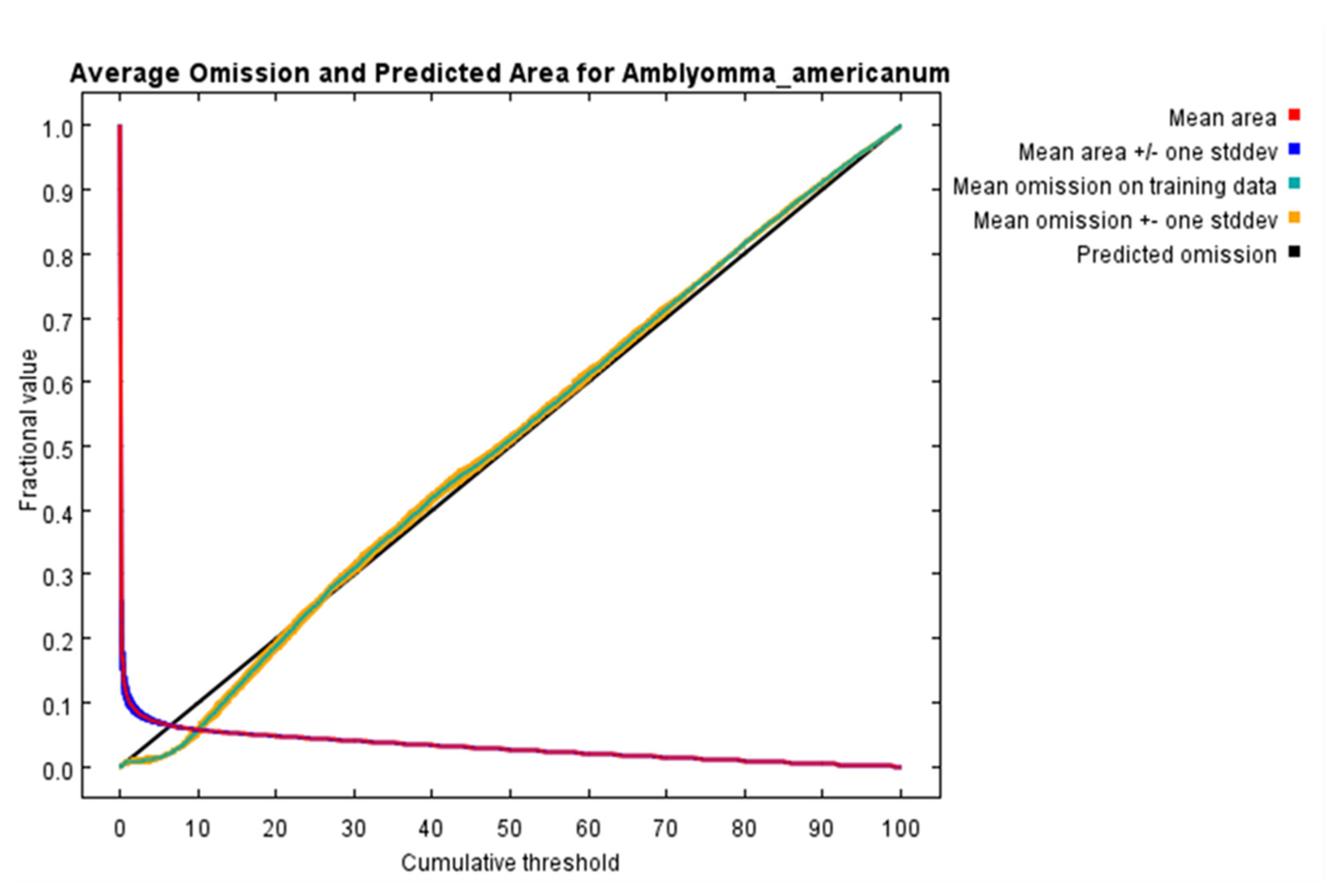

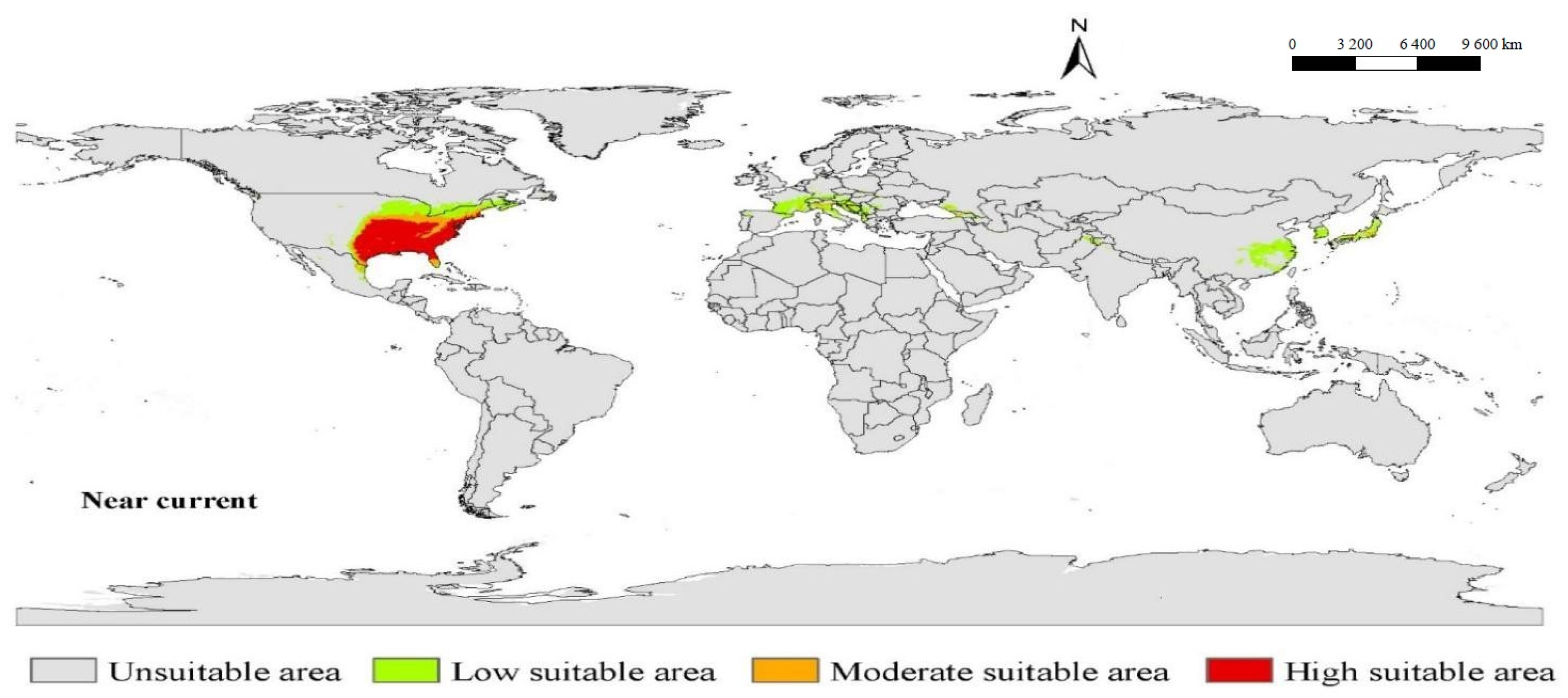
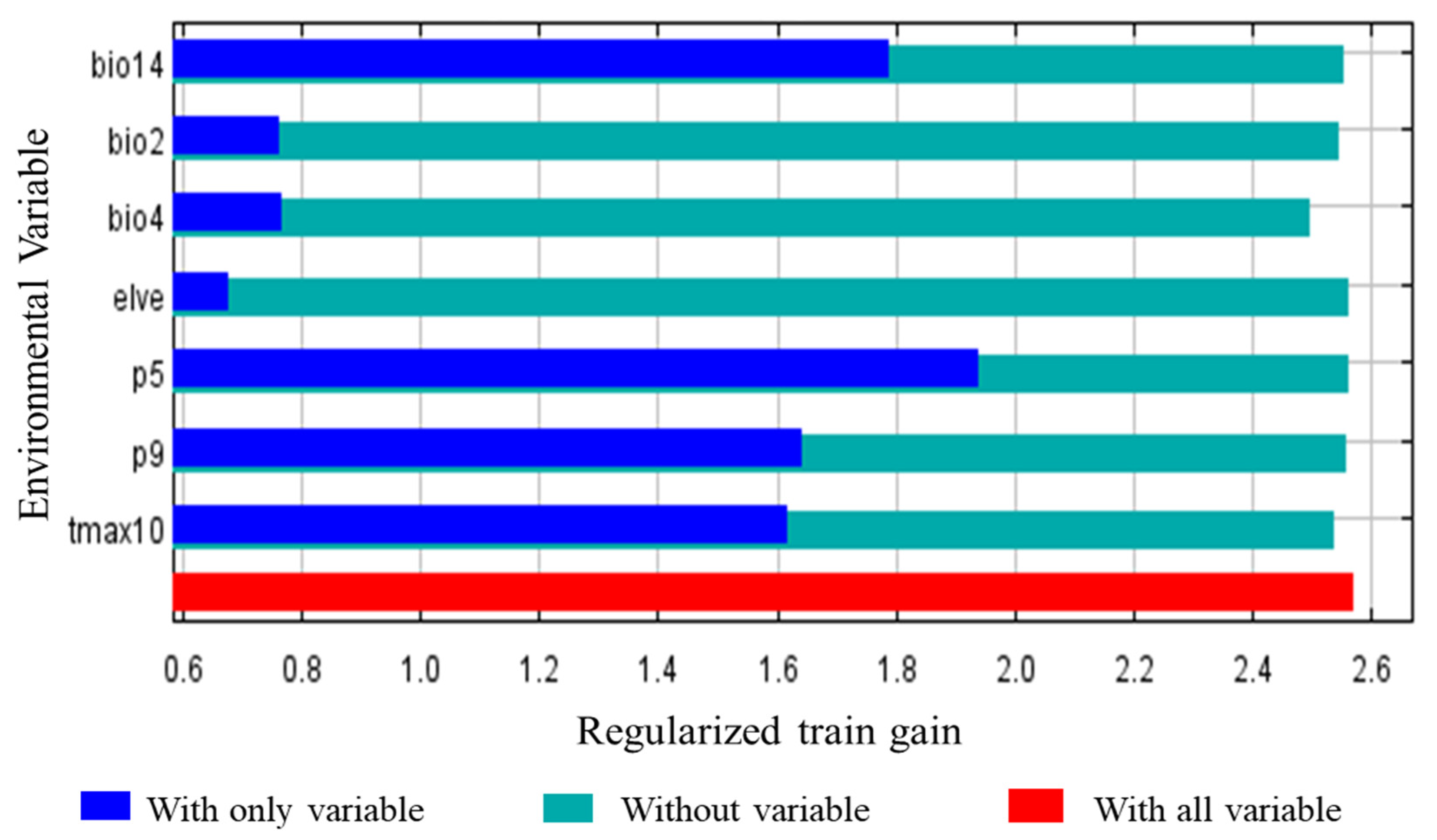

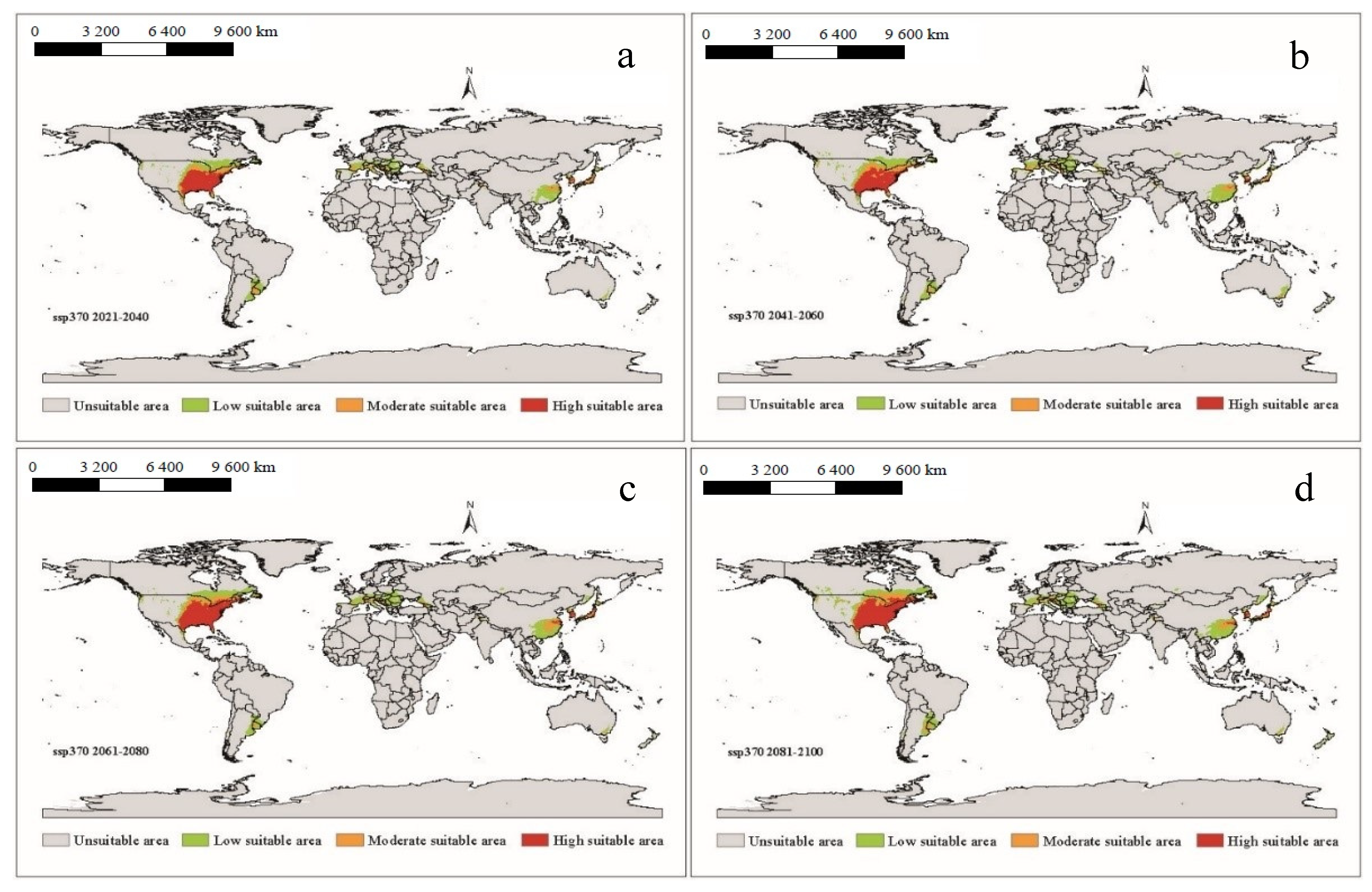
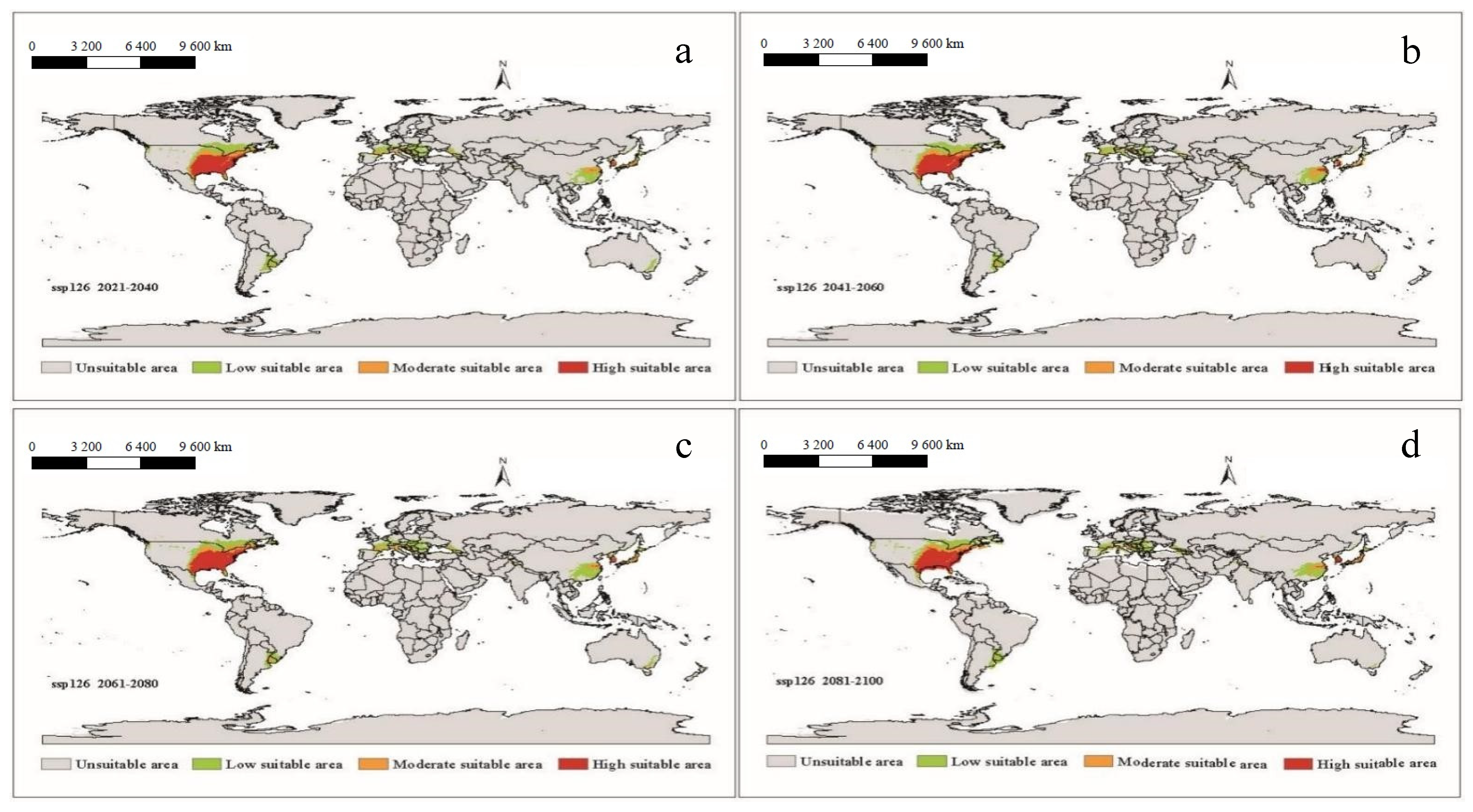
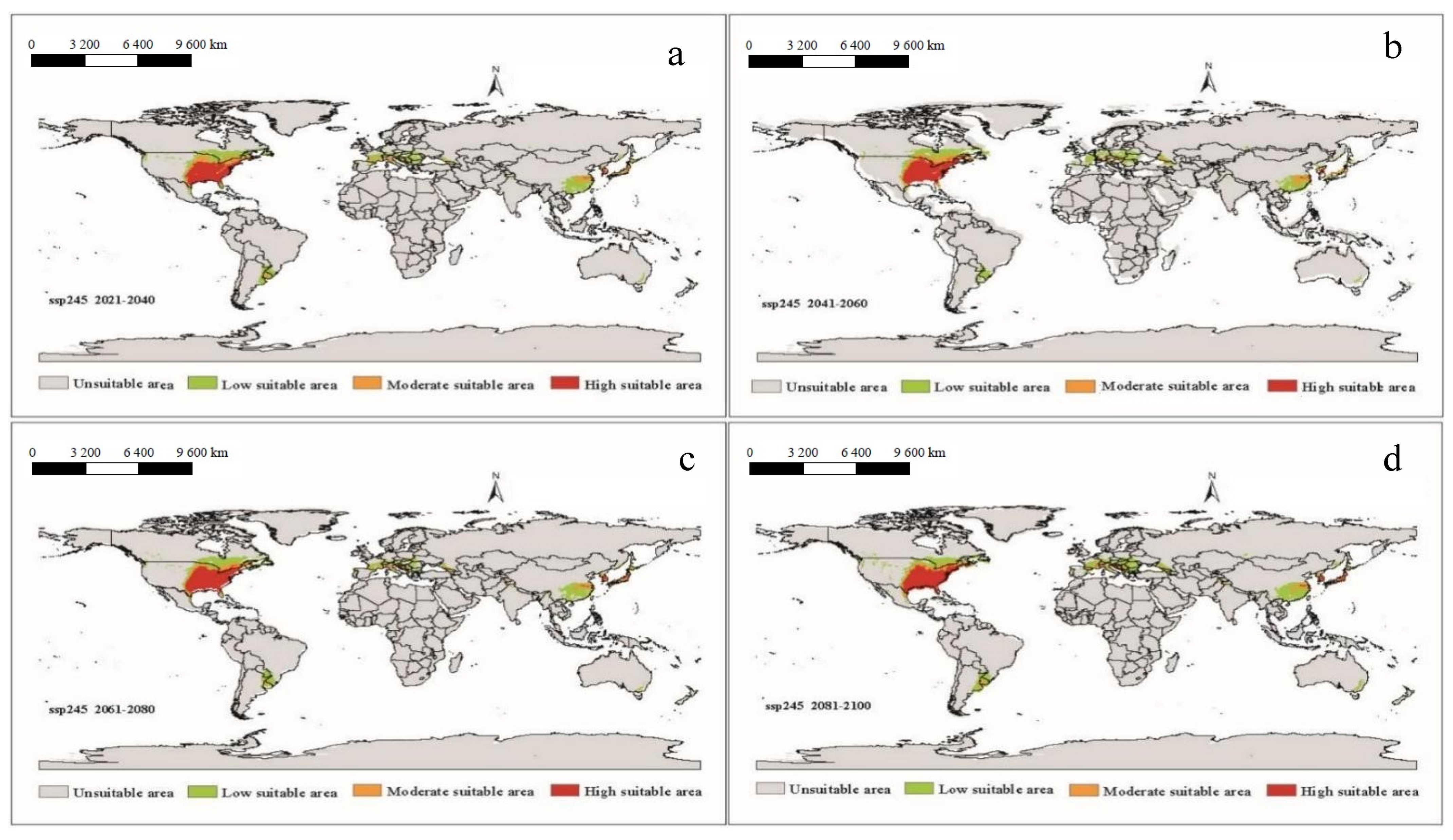

| Variables | Description | Unit | Contribution (%) |
|---|---|---|---|
| Prec5 | Precipitation in May | mm | 41.9 |
| BIO14 | Precipitation of the driest month | mm | 30.6 |
| BIO4 | Temperature seasonality (standard deviation × 100) | \ | 16.8 |
| Tmax10 | Temperature in October | °C | 4.5 |
| BIO2 | Mean diurnal range (mean of monthly (max temp–min temp)) | °C | 4.3 |
| Prec9 | Precipitation in September | mm | 1.2 |
| Elevation | Elevation | m | 0.8 |
| Climate Scenario | Period | Less Suitable Areas | Moderately Suitable Areas | Highly Suitable Areas | Total Area | Area Change | Area Change Ratio (%) |
|---|---|---|---|---|---|---|---|
| current | 1970–2000 | 1.66 | 0.49 | 1.24 | 3.39 | 0.00 | |
| ssp1-2.6 | 2021–2040 | 3.29 | 0.98 | 1.56 | 5.83 | 2.44 | 71.98 |
| 2041–2060 | 2.84 | 1.03 | 1.67 | 5.54 | 2.15 | 63.42 | |
| 2061–2080 | 3.18 | 1.04 | 1.64 | 5.86 | 2.47 | 72.86 | |
| 2081–2100 | 3.11 | 1.07 | 1.81 | 5.99 | 2.60 | 76.70 | |
| ssp2-4.5 | 2021–2040 | 3.23 | 1.10 | 1.60 | 5.93 | 2.54 | 74.93 |
| 2041–2060 | 3.17 | 1.15 | 1.84 | 6.16 | 2.77 | 81.71 | |
| 2061–2080 | 3.06 | 1.06 | 1.92 | 6.04 | 2.65 | 78.17 | |
| 2081–2100 | 3.67 | 1.13 | 2.01 | 6.81 | 3.41 | 100.59 | |
| ssp3-7.0 | 2021–2040 | 3.06 | 1.01 | 1.56 | 5.63 | 2.24 | 66.08 |
| 2041–2060 | 3.56 | 1.27 | 1.69 | 6.52 | 3.13 | 92.33 | |
| 2061–2080 | 3.32 | 1.22 | 2.11 | 6.66 | 3.26 | 96.17 | |
| 2081–2100 | 3.77 | 1.29 | 2.31 | 7.37 | 3.97 | 117.11 | |
| ssp5-8.5 | 2021–2040 | 3.13 | 1.11 | 1.71 | 5.95 | 2.56 | 75.52 |
| 2041–2060 | 3.01 | 1.19 | 1.80 | 6.00 | 2.61 | 76.99 | |
| 2061–2080 | 3.45 | 1.28 | 1.90 | 6.63 | 3.24 | 95.58 | |
| 2081–2100 | 3.38 | 1.62 | 2.14 | 7.14 | 3.75 | 110.62 |
Publisher’s Note: MDPI stays neutral with regard to jurisdictional claims in published maps and institutional affiliations. |
© 2021 by the authors. Licensee MDPI, Basel, Switzerland. This article is an open access article distributed under the terms and conditions of the Creative Commons Attribution (CC BY) license (https://creativecommons.org/licenses/by/4.0/).
Share and Cite
Ma, D.; Lun, X.; Li, C.; Zhou, R.; Zhao, Z.; Wang, J.; Zhang, Q.; Liu, Q. Predicting the Potential Global Distribution of Amblyomma americanum (Acari: Ixodidae) under Near Current and Future Climatic Conditions, Using the Maximum Entropy Model. Biology 2021, 10, 1057. https://doi.org/10.3390/biology10101057
Ma D, Lun X, Li C, Zhou R, Zhao Z, Wang J, Zhang Q, Liu Q. Predicting the Potential Global Distribution of Amblyomma americanum (Acari: Ixodidae) under Near Current and Future Climatic Conditions, Using the Maximum Entropy Model. Biology. 2021; 10(10):1057. https://doi.org/10.3390/biology10101057
Chicago/Turabian StyleMa, Delong, Xinchang Lun, Chao Li, Ruobing Zhou, Zhe Zhao, Jun Wang, Qinfeng Zhang, and Qiyong Liu. 2021. "Predicting the Potential Global Distribution of Amblyomma americanum (Acari: Ixodidae) under Near Current and Future Climatic Conditions, Using the Maximum Entropy Model" Biology 10, no. 10: 1057. https://doi.org/10.3390/biology10101057
APA StyleMa, D., Lun, X., Li, C., Zhou, R., Zhao, Z., Wang, J., Zhang, Q., & Liu, Q. (2021). Predicting the Potential Global Distribution of Amblyomma americanum (Acari: Ixodidae) under Near Current and Future Climatic Conditions, Using the Maximum Entropy Model. Biology, 10(10), 1057. https://doi.org/10.3390/biology10101057





